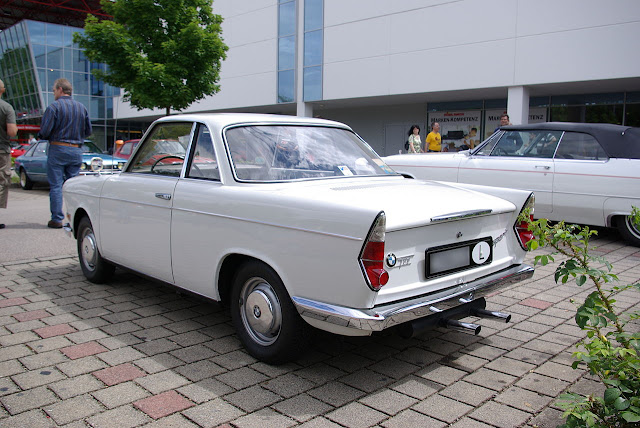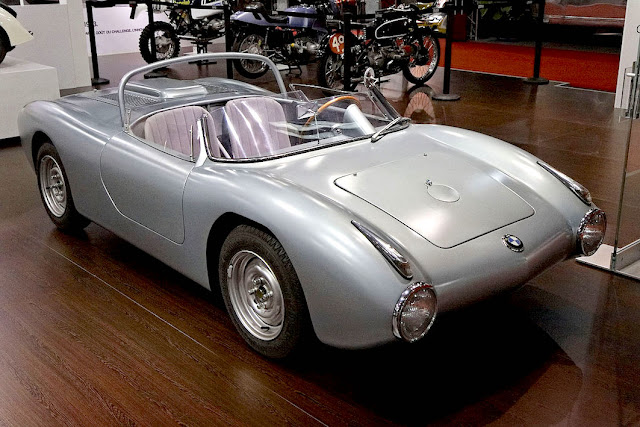The BMW 700 was a small rear-engined car produced by BMW in various models from August 1959 to November 1965. It was a sales success at a time when BMW was close to financial ruin. Upon discontinuing the 700, BMW left the economy car market and did not return until 2002 with the Mini.
The 700 used a steel monocoque structure, and was the first BMW automobile to do so. The engine was an enlarged version of a 697 cc Flat twin that was used in the R67 motorcycle. The twin-cylinder four-stroke air-cooled engine, attached to a four-speed box, developed 30hp for the sedan, 40hp for the coupe. It allowed the engine to be very torquey, while having a limited consumption.
In January 1958, Wolfgang Denzel, the distributor of BMW cars in Austria, was awarded a development contract for the 700. Denzel presented a prototype, designed by Giovanni Michelotti, to BMW's management in July 1958. The concept, a 2-door coupé with a slanted roof, was generally well received, but objections were raised about the limited passenger space. BMW decided to produce two versions, the coupé, and a 2-door sedan with a taller, longer roof.
Both versions of the 700 were shown at the 1959 Frankfurt Motor Show. Production of the BMW 700 began in August 1959. The large number of orders was welcome news for BMW, which was in a financial crisis. In December 1959, shareholders blocked a proposal by BMW's supervisory board to merge BMW into Daimler-Benz. 188,211 BMW 700s were built before production ended in November 1965. (wikipedia)
The most significant change came in spring 1962 when BMW, while retaining the car's wheelbase, extended the body by no less than 32 cm or 12.6' in order to offer a significant increase in motoring comfort. This new model was marketed as the BMW LS and the BMW LS De Luxe. As of autumn 1964 the Coupé also received this longer body, coming off the assembly line in its last year of production as the BMW LS Coupé. (auto.samondeo.com)
Both versions of the 700 were shown at the 1959 Frankfurt Motor Show. Production of the BMW 700 began in August 1959. The large number of orders was welcome news for BMW, which was in a financial crisis. In December 1959, shareholders blocked a proposal by BMW's supervisory board to merge BMW into Daimler-Benz. 188,211 BMW 700s were built before production ended in November 1965. (wikipedia)
The most significant change came in spring 1962 when BMW, while retaining the car's wheelbase, extended the body by no less than 32 cm or 12.6' in order to offer a significant increase in motoring comfort. This new model was marketed as the BMW LS and the BMW LS De Luxe. As of autumn 1964 the Coupé also received this longer body, coming off the assembly line in its last year of production as the BMW LS Coupé. (auto.samondeo.com)
BMW 700 Coupé
The first variant of the 700 to appear after the original coupé and saloon was the 700 Sport in August 1960. Available only as a coupé, the Sport used an uprated engine that brought the power output to 40 hp (30 kW). The Sport also had a rear anti-roll bar. A ribbed oil pan was used to reduce the oil temperature of the more powerful engine. The 700 Sport was renamed the 700 CS in 1963.
700 LS Coupé
The final development of the 700 was the 700 LS Coupé of 1964. This was a long-wheelbase coupé with the Sport engine. 1,730 LS Coupés were built.
BMW 700 Sedan
700 LS Luxus
The 700 Luxus replaced the original sedan in 1962. The wheelbase had been extended by 16 centimetres (6.3 in). The 700 LS, a simplified Luxus with a lower price, was introduced in 1963.
BMW 700 Convertible
The 700 Cabriolet was introduced shortly after the 700 Sport, and was available only with the Sport's 40 hp engine. The convertible body was made by Karosserie Baur of Stuttgart. 2,592 convertibles were built.
BMW 700 RS
The 700 RS was a racing car based on the 700. It had a tubular frame chassis, special, lightweight, aerodynamic bodywork, and a double overhead camshaft engine tuned to 70 PS (51 kW; 69 hp). Hans Stuck campaigned the 700RS with success. It entered the Rossfeld Hillclimb Race on 18 June 1961. Only 19 examples of the 700 RS were created.
(Photos from petrolicious.com, flickr.com, ommons.wikimedia.org,
gullwingmotorcars.com, allcarcentral.com, lautomobileancienne.com,
stanceworks.com & thegegeblog.canalblog.com)
gullwingmotorcars.com, allcarcentral.com, lautomobileancienne.com,
stanceworks.com & thegegeblog.canalblog.com)


































































































































